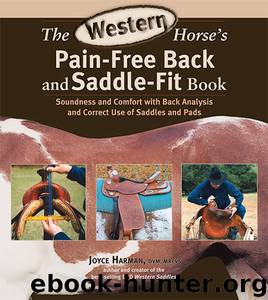The Western Horse's Pain-Free Back and Saddle-Fit Book: Soundness and Comfort with Back Analysis and Correct Use of Saddles and Pads by Joyce Harman

Author:Joyce Harman [Harman, Joyce]
Language: eng
Format: epub
Publisher: Trafalgar Square Books
Published: 2015-05-10T07:00:00+00:00
Narrow Backs
8.3 A–C The horse in A has a narrow back with little muscle along the spine, especially near the withers. The view of the horse in B shows how the spine can protrude along a narrow back, and in C, you can clearly see how muscle can atrophy along the withers just behind the shoulder blades.
Narrow backs can be found in any breed but are most commonly seen in Arabians, Paso Finos, Icelandics, Tennessee Walkers, American Saddle-breds, and Thoroughbreds. They are also prevalent in endurance horses with very little extra fat or muscle because of long distance training, or in horses that have worn poorly fitting saddles and now have atrophied or wasted muscle along their topline (see fig. 8.3 C).
Some horses with narrow backs are fairly flat under the cantle area of the saddle, while others show more angulation there. Most commonly, Arabians, Lusitanos, and Connemaras have angled backs. When a horse with this conformation raises his back, there is considerable upward movement at the top of the rib cage (toward the outer edges of the bars). It is, therefore, important to use a saddle with the bars at the correct angle. Otherwise, a linear area of pressure is created under the outer edges of the bars.
The key to fitting a narrow horse, or one with a steeply angled back, is to make sure that the saddle sits on the back muscles, and not close to, or actually on, the spine. Generally, a narrow gullet is the answer, rather than steeper bars. Be sure there is enough clearance for the withers (see p. 80). If you can easily see your horse’s backbone, especially if it rises well above the back muscles, you may need a slightly thicker pad, such as a 1½ inch thick pad, to protect the spine.
Some horses will require a steeper angle to the bars, as well, and many Arabian-type bars have an 86-degree angle that can be appropriate (fig. 8.4). The old McClellan army saddles also have very steep bar angles, as do many antique saddles.
Bars for Narrow Backs
8.4 The bars on this saddle slope more steeply and follow the angle of the narrow back. This allows a rider’s weight to be equally and evenly supported by the bars.
Download
This site does not store any files on its server. We only index and link to content provided by other sites. Please contact the content providers to delete copyright contents if any and email us, we'll remove relevant links or contents immediately.
| Equestrian | Polo |
| Racing |
Shoe Dog by Phil Knight(5139)
The Rules Do Not Apply by Ariel Levy(4842)
Walking by Henry David Thoreau(3892)
How to Read Water: Clues and Patterns from Puddles to the Sea (Natural Navigation) by Tristan Gooley(3406)
Running Barefoot by Amy Harmon(3396)
I'll Give You the Sun by Jandy Nelson(3356)
Crazy Is My Superpower by A.J. Mendez Brooks(3328)
How to Read Nature by Tristan Gooley(3249)
How Music Works by David Byrne(3184)
The Boy, the Mole, the Fox and the Horse by Charlie Mackesy(2998)
The Fight by Norman Mailer(2846)
Seducing Cinderella by Gina L. Maxwell(2604)
Cuba by Lonely Planet(2576)
Accepted by Pat Patterson(2302)
Going Long by Editors of Runner's World(2294)
The Unfettered Mind: Writings from a Zen Master to a Master Swordsman by Takuan Soho(2249)
Backpacker the Complete Guide to Backpacking by Backpacker Magazine(2193)
The Happy Runner by David Roche(2193)
Trail Magic by Trevelyan Quest Edwards & Hazel Edwards(2125)
